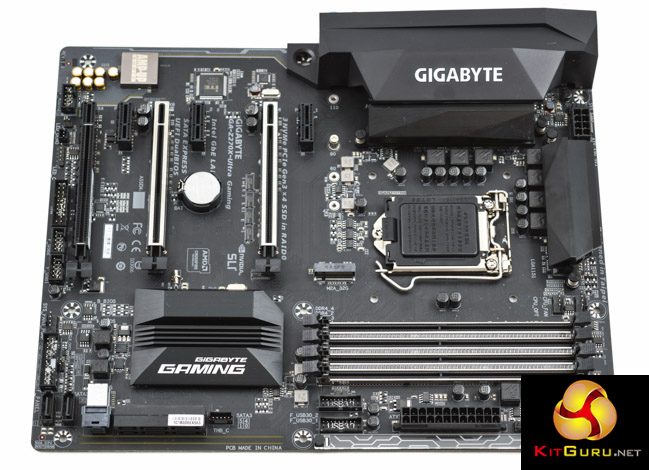As with most product launches Z270 motherboards will command a price premium compared to equivalent Z170 motherboards until the launch buzz around Z270 and Kaby Lake dies down, stock begins to flow into retail channels and old Z170 stock is sold out. For the time being there are most likely some bargains to be had in Z170 inventories for consumers that are willing to part with their cash for a “last-gen” product.
However, for consumers wanting to get a latest generation Intel motherboard Gigabyte's Z270X-Ultra Gaming still represents good value for money at an estimated retail price of £160. That price puts it in competition with a large number of motherboards from the new Z270 generation and the previous Z170 generation but despite the intense competition, Gigabyte's latest mid-range offering stands up well.

With U.2, M.2, SATA Express, SATA III, USB 3.0, USB 3.1 and USB Type-C the Gigabyte Z270X-Ultra Gaming has just about all bases covered when it comes to storage options. Only a second M.2 is something that might be missed but the exclusion of this is a trade-off for the inclusion of the U.2 port. At this price point we'd argue that a second M.2 slot is more likely to be used than a U.2 port, but it's also highly unlikely buyers will have two M.2 drives either.
While the rear I/O connectivity is solid for the price point, and relative to the competition, the I/O looks a bit empty and we feel a couple more USB ports would have been a nice touch. Gigabyte provides four USB headers, which could expand for up to 8 more USB ports, but few cases have that many USB ports at the front. Unless the user is making use of internal USB headers with card readers or other devices then this USB capability could be under-utilised.
In keeping with the wider motherboard trends we were pleased to see Gigabyte add fully-configurable RGB support and do so in so many areas of the motherboard. This is in addition to providing an RGB header on the motherboard and producing a tidy overall aesthetic with a matte black PCB and slot shielding for the PCIe and Memory lanes.
The only significant issue with the Z270X-Ultra Gaming, aside from an overly high auto voltage, is the UEFI not being as intuitive to use as it should be in terms of the layout and structure of the menus. Gigabyte needs to invest some time and effort into conducting user experience and usability testing to streamline the UEFI experience. It's worth noting that the content of the UEFI is up to scratch meaning that all the key options and adjustment parameters are there, it just doesn't feel all that pleasant to use.
The Gigabyte Z270X-Ultra Gaming is available at Overclockers UK for £149.99.
Discuss on our Facebook page, over HERE.
Pros:
- Clean aesthetics
- Multi-zone configurable RGB LEDs
- Balanced range of storage and peripheral connectivity
- Extensive software suite with unifying APP Center control panel
- Improved audio solution
- Reinforced PCIe slots and memory lanes
Cons:
- UEFI layout could be more intuitive
- Auto CPU voltage is too high
- Strange water pump header location
- CPU VRM could be improved
KitGuru says: The Gigabyte Z270X-Ultra Gaming is a solid gaming motherboard choice for Kaby Lake and deserves to be on any shortlist at this price point.
 KitGuru KitGuru.net – Tech News | Hardware News | Hardware Reviews | IOS | Mobile | Gaming | Graphics Cards
KitGuru KitGuru.net – Tech News | Hardware News | Hardware Reviews | IOS | Mobile | Gaming | Graphics Cards



I think I’m over with all these hardwares. The customer service is rubbish left, right, up and down, vendors and manufacture alike, MSI, Samsung the list goes on… I lost a M.2 screw, and MSI’s support could care less.
Hello Ryan
I’ve just bought this board for my new build. Do you think there’s a way to make the auto voltage function less aggressive?
Thanks 🙂
Hey, you could apply a core voltage offset. I discussed it at the bottom of the UEFI page. I found that -0.1 was enough to keep power down and was still perfectly stable. You may be able to get a lower voltage yourself (-0.1 to -0.2) depending on your CPUs capability. You could also choose a lower LLC setting instead of the Auto LLC setting. The core voltage offset is under MIT-CPU Core Voltage Control, if you leave the core voltage as auto then do the dynamic vcore option (use + and – on the keyboard to get down to -0.1, it’s a bit fiddly). MIT-Advanced Power Options has the LLC setting. Medium or lower should keep the voltage a bit less aggressive but the offset will be the most effective way.
Gigabyte may well alter the voltage behaviour with BIOS updates too so keep an eye out! Also be sure to have the “balanced” windows power profile to get adequate clocking/voltage down for less intensive tasks.
Alright, thanks for the tips!
I’ll make sure to look out for future updates.
The correct screw size is 2.0 x 3mm (CM2x3-3.3)
should be available at hardware / electronics stores.
Thanks for the suggestion, I’ve gone to two electronics stores specialising in screws, nuts and bolts, none of them has anything remotely as small as the M.2 screws. Hope, some manufacturers in computers parts will make them for sale in the future.
Isn’t that audio test pretty seriously flawed? If you do loop back the results are only as good as the line in ADC is and doesn’t really tell anything about the line out DAC quality. Judging by Realtek ALC1220 specs it has much worse line in than line out quality.
Can i run my I7 6700K on this Board?
yes
I see the F4 Bios has ‘V-Core Voltage Adjust’ has anyone used this and did it correct the high auto voltage issue?
Really? This board gets a 8 / 10 when by the picture it looks like it has a craptacular 7 phases? Combine that with the UEFI layout issues, bad auto voltages and thats plenty to bring it down to a 7 / 10.
Stop kissing Gigabytes arse and rate things accordingly.
eu preciso aprender a configurar a memoria g.skil 3200mhz nessa placa. alguem pode me ajudar?
does this motherboard support NVME?
its about what’s said in the reviews, not about the ratings themselves.
the Written Reviews tell you a lot more then just some arbitrary subjective-rating.
an 8/10, 7/10 and even a 6/10 could have a lot different meanings and interpretations base on the person. Some people may not view a 8/10 not that highly while a 6/10 might be seen as a ‘good’ score, to some.
It’s all based on the person perception of the numbers. You can’t objectively score a product like a video-game for example.
That’s why its important to read the ACTUAL review, rather then just look at the Rating/awards given to it. To see what is actually said about the product and make an informed decision based on that, rather then trying to make a decision based off an arbitrary rating.
Fallout New Vegas for example got a 84 on metacritic, though in my opinion its one of best games of that year, even now in my opinion it still holds up quite well as a great game. That said, it got an 84 out of 100 for a score. Does Scoring really matter? It’s meant to give a generic-overall view of the game in simple terms. like “Great Game” or “Great Product”.
7/10, 10/10, 1/10, etc doesn’t matter. What matters is the content of the review, what they say about the product itself, how it runs, it feels, how it looks, features, how it compares to other products in its industry, etc. Don’t take the 8/10 to heart, too much just because you feel the score should be different. Numbers mean different things to different people, so an 8 is not always the “8” the way you may be perceiving it.
Yes, but will depend on how many PCIE lanes you are using and your CPU.
If i enter a value of 1-1.299 it will work and when i put 1.35 for example it switches the mode to AUTO and locks at 1.3
On page 10 of the first guide he specifies how he has a profile with 1.35 voltage and on the second link there are screenshots of him at 1.375
https://view.joomag.com/gigabyte-z270-overclocking-guide-gigabyte-200-series-overclocking-guide/0767815001483933769
http://www.kitguru.net/components/motherboard/ryan-martin/gigabyte-z270x-ultra-gaming-motherboard-review/4/
Is it because I am on version f6 of the BIOS or is my mobo simply locked @ 1.3?
In the first guide he also mentioned how he set his CPU Vcore Loadline Calibration to TURBO and I don’t have this setting available
Z270P-D3 + i7-7700k BIOS version f6